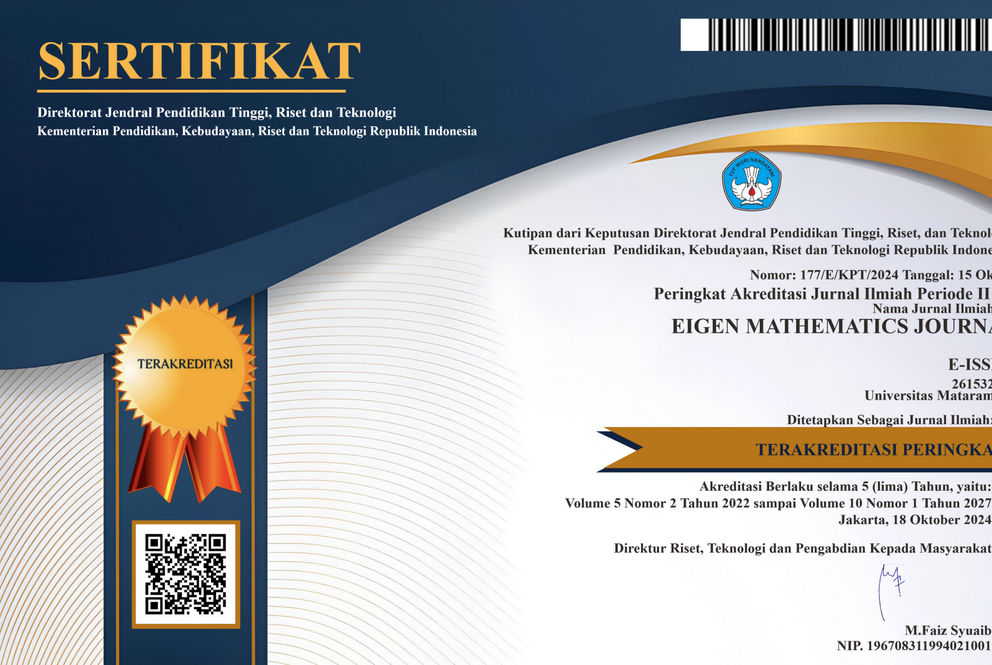Implementation of Random Forest Algorithm to Classify Earthquake in Indonesia
DOI:
https://doi.org/10.29303/emj.v8i1.185Keywords:
random forest algorithm, earthquake, classification, tsunamiAbstract
Earthquakes are shocks that occur on the surface of the earth due to shifts in the earth's plates. Geographically, Indonesia is located in the Pacific Ring of Fire (King of Fire) region, this makes Indonesia prone to earthquakes. Earthquakes can cause environmental damage and tsunami disasters, but not all earthquakes can cause tsunamis. Classifying earthquakes that have the potential for a tsunami is very important to mitigate the damage caused. One classification method that has a high level of accuracy is random forest. The advantage of random forest is that this algorithm tends to be resistant to overfitting and can handle large data. This research uses real-time earthquake data from July to August 2023, sourced from the website of the Meteorology Climatology and Geophysics Agency (BMKG). The training data and test data used in this research are 70% and 30%. Confution Matrix is used as model evaluation, to measure the accuracy of the classification model. The results of this research obtained a high accuracy, equal 0.97 or 97%.References
T. Duha, M. Laia, A. K. Huda, and A. Jasuma, “Klasifikasi data gempa bumi di pulau sumatera menggunakan algoritma naïve bayes,” Jurnal Informatika, vol. 2, no. 1, pp. 23–27, 2023. https://doi.org/10.57094/ji.v2i1.840.
H. Tantyoko, D. K. Sari, and A. R. Wijaya, “Prediksi potensial gempa bumi indonesia menggunakan metode random forest dan feature selection,” IDEALIS: Indonesia Journal Information System, vol. 6, no. 2, pp. 83–89, 2023.
D. Deswita, S. Yuliharni, and N. N. Efniyati, “Studi kasus: Gambaran kesiapsiagaan remaja menghadapi gempa bumi dan tsunami,” Jurnal’Aisyiyah Medika, vol. 8, no. 2, 2023. https://doi.org/10.36729/jam.v8i2.1112.
F. Mu’alim and R. Hidayati, “Implementasi metode random forest untuk penjurusan siswa di madrasah aliyah negeri sintang,” JUPITER: Jurnal Penelitian Ilmu dan Teknologi Komputer, vol. 14, no. 1, pp. 116–125, 2022. https://doi.org/10.5281./4588/5.jupiter.2022.04.
I. Ismail, “Klasifikasi area gempa bumi menggunakan algoritma random forest,” Jurnal Ilmiah Informatika Komputer, vol. 26, no. 1, pp. 56–64, 2021. https://doi.org/10.35760/ik.2021.v26i1.3853.
T. Tambunan, M. Yohanna, and A. P. Silalahi, “Penerapan metode random forest dalam mendeteksi berita hoax,” METHOMIKA: Jurnal Manajemen Informatika & Komputerisasi Akuntansi, vol. 7, no. 2, pp. 301–306, 2023. https://doi.org/10.46880/jmika.Vol7No2.pp301-306.
F. Fauzi, W. Setiayani, T. W. Utami, E. Yuliyanto, and I. W. Harmoko, “Comparison of random forest and naïve bayes classifier methods in sentiment analysis on climate change issue,” BAREKENG: Jurnal Ilmu Matematika dan Terapan, vol. 17, no. 3, pp. 1439–1448, 2023. https://doi.org/10.30598/barekengvol17iss3pp1439-1448.
S. Devella, Y. Yohannes, and F. N. Rahmawati, “Implementasi random forest untuk klasifikasi motif songket palembang berdasarkan sift,” JATISI (Jurnal Teknik Informatika dan Sistem Informasi), vol. 7, no. 2, pp. 310–320, 2020. https://doi.org/10.35957/jatisi.v7i2.289.
O. W. Yuda, D. Tuti, et al., “Penerapan penerapan data mining untuk klasifikasi kelulusan mahasiswa tepat waktu menggunakan metode random forest,” SATIN-Sains Dan Teknologi Informasi, vol. 8, no. 2, pp. 122–131, 2022. https://doi.org/10.33372/stn.v8i2.885.
S. Amaliah, M. Nusrang, and A. Aswi, “Penerapan metode random forest untuk klasifikasi varian minuman kopi di kedai kopi konijiwa bantaeng,” VARIANSI: Journal of Statistics and Its application on Teaching and Research, vol. 4, no. 3, pp. 121–127, 2022. https://doi.org/10.35580/variansiunm31.
Downloads
Published
How to Cite
Issue
Section
License

This work is licensed under a Creative Commons Attribution-NonCommercial-ShareAlike 4.0 International License.
All articles published in the Eigen Mathematics Journal will be available for free reading and downloading. The license applied to this journal is Creative Commons Attribution-Non-Commercial-Share Alike (CC BY-NC-SA).






